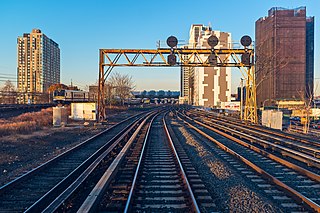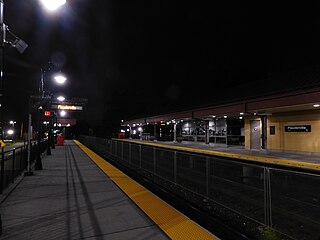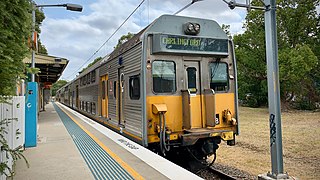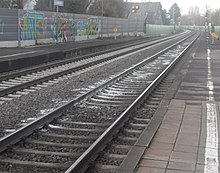
A level crossing is an intersection where a railway line crosses a road, path, or airport runway, at the same level, as opposed to the railway line crossing over or under using an overpass or tunnel. The term also applies when a light rail line with separate right-of-way or reserved track crosses a road in the same fashion. Other names include railway level crossing, railway crossing, grade crossing or railroad crossing, road through railroad, criss-cross, train crossing, and RXR (abbreviated).

Gardiner railway station is a commuter railway station in Glen Iris, a suburb of Melbourne, Victoria, Australia. The station opened on 24 March 1890, named after pastoralist John Gardiner, who had settled near the junction of the Yarra River and Gardiners Creek in 1836.

Metrolink's Riverside Line is a commuter rail line running from L.A. Union Station in Downtown Los Angeles to Riverside along the Union Pacific Railroad. It runs weekday peak commuter hours only, with very little midday and reverse commute service. In 2011, the average weekday ridership was 5,161 passengers.

The Jamaica station is a major train station of the Long Island Rail Road located in Jamaica, Queens, New York City. With weekday ridership exceeding 200,000 passengers, it is the largest transit hub on Long Island, the fourth-busiest rail station in North America, and the second-busiest station that exclusively serves commuter traffic. It is the third-busiest rail hub in the New York area, behind Penn Station and Grand Central Terminal. Over 1,000 trains pass through each day, the fourth-most in the New York area behind Penn Station, Grand Central Terminal, and Secaucus Junction.

The Keystone Corridor is a 349-mile (562 km) railroad corridor between Philadelphia and Pittsburgh, Pennsylvania, that consists of two rail lines: Amtrak and SEPTA's Philadelphia-to-Harrisburg main line, which hosts SEPTA's Paoli/Thorndale Line commuter rail service, and Amtrak's Keystone Service and Pennsylvanian inter-city trains; and the Norfolk Southern Pittsburgh Line. The corridor was originally the Main Line of the Pennsylvania Railroad.

Downtown Mountain View station is an intermodal transit station providing public bus and rail service, located in Mountain View, California. The station is served by the Caltrain commuter rail service, for which it is simply called Mountain View station. Santa Clara VTA Orange Line light rail service is provided to an adjacent, dedicated light rail facility, known as Downtown Mountain View station. VTA local transit bus and employer-operated shuttle services are accommodated from the Mountain View Transit Center on the Evelyn Avenue side of the station.

Little Neck is a station on the Long Island Rail Road's Port Washington Branch in the Little Neck neighborhood of Queens, New York City. The station is at Little Neck Parkway and 39th Road, about half a mile north of Northern Boulevard. Little Neck station is 14.5 miles (23.3 km) from Penn Station in Midtown Manhattan, and is the easternmost station on the Port Washington Branch in New York City. The station house is located on the south (eastbound) side, unlike most station houses on the Port Washington Branch. The station is part of the CityTicket program and is in Zone 3.

An axle counter is a system used in railway signalling to detect the clear or occupied status of a section of track between two points. The system generally consists of a wheel sensor and an evaluation unit for counting the axles of the train both into and out of the section. They are often used to replace a track circuit.

The Port Jefferson Branch is a rail line and service owned and operated by the Long Island Rail Road in the U.S. state of New York. The branch splits from the Main Line just east of Hicksville and runs northeast and east to Port Jefferson. Several stations on the Main Line west of Hicksville are served primarily by trains bound to/from the Port Jefferson branch, so LIRR maps and schedules for the public include that part of the Main Line in the "Port Jefferson Branch" service.

Tactile paving is a system of textured ground surface indicators found at roadsides, by and on stairs, and on railway station platforms, to assist pedestrians who are vision impaired.

The Mineola Intermodal Center is an intermodal center and transportation hub in the village of Mineola, Nassau County, New York, U.S. It contains the Mineola Long Island Rail Road station – one of the railroad's busiest stations – in addition to one of the Nassau Inter-County Express bus system's main hubs, located adjacent to the southern train platform.

New Hyde Park is a Long Island Rail Road station on the Main Line. It is located at New Hyde Park Road and Second Avenue in New Hyde Park, New York. The station house was near the eastern part of the westbound platform, it is now demolished for the accommodation of the LIRR's third track expansion project. The station is wheelchair accessible and had two grade crossings on either side of the station; however, as of 2020, both have been demolished and turned into an underpasses. It is only listed on the Port Jefferson Branch timetable and most service is provided by that branch.

The Main Line is a rail line owned and operated by the Long Island Rail Road in the U.S. state of New York. It begins as a two-track line at Long Island City station in Long Island City, Queens, and runs along the middle of Long Island about 95 miles (153 km) to Greenport station in Greenport, Suffolk County. At Harold Interlocking approximately one mile east of Long Island City, the tracks from the East River Tunnels and 63rd Street Tunnel into Manhattan intersect with the Main Line, which most trains use rather than using the Long Island City station.

Huntington is a station on the Port Jefferson Branch of the Long Island Rail Road. It is located near New York Avenue, connecting it to Melville, the Long Island Expressway and Huntington and Broadway in Huntington Station, New York.

Plauderville is a NJ Transit train station located in Garfield, New Jersey, United States, served by the Bergen County Line. The station is in the north side of the city on Midland Avenue between Plauderville Avenue and Outwater Lane. The station is a full-service station as of April 2012, and has high-level platforms making the station accessible for people with disabilities.

Wyandanch is a station along the Main Line of the Long Island Rail Road. It is located on Straight Path and Long Island Avenue, off Acorn Avenue in Wyandanch, New York. All parking near the station is free, and maintained either by Suffolk County or the Town of Babylon.

The Carlingford railway line was a railway line in Sydney, New South Wales, Australia. It was opened from Clyde to Subiaco in January 1885, then by means of the construction of a bridge across the Parramatta River, to Carlingford in April 1896. It closed on 5 January 2020 with much of the line to be converted to light rail as part of the Parramatta Light Rail network, while a short section of the line was retained for use by Sydney Trains.

The Staten Island Railway (SIR) is the only rapid transit line in the New York City borough of Staten Island and is operated by the Staten Island Rapid Transit Operating Authority, a unit of the Metropolitan Transportation Authority. The railway was historically considered a standard railroad line, but today only the western portion of the North Shore Branch, which is disconnected from the rest of the SIR, is used by freight and is connected to the national railway system.

There are around 6,000 level crossings in the United Kingdom, of which about 1,500 are public highway crossings. This number is gradually being reduced as the risk of accidents at level crossings is considered high. The director of the UK Railway Inspectorate commented in 2004 that "the use of level crossings contributes the greatest potential for catastrophic risk on the railways." The creation of new level crossings on the national network is banned, with bridges and tunnels being the more favoured options. The cost of making significant reductions, other than by simply closing the crossings, is substantial; some commentators argue that the money could be better spent. Some 5,000 crossings are user-worked crossings or footpaths with very low usage. The removal of crossings can improve train performance and lower accident rates, as some crossings have low rail speed limits enforced on them to protect road users. In fact, between 1845 and 1933, there was a 4 miles per hour (6.4 km/h) speed limit on level crossings of turnpike roads adjacent to stations for lines whose authorising act of Parliament had been consolidated in the Railways Clauses Consolidation Act 1845 although this limit was at least sometimes disregarded.
Pedestrian railroad safety is concerned with the protection of life through regulation, management and technology development of all forms of rail transportation. In the United States there are some 180,000 miles of track. Pedestrian railroad accidents are the leading cause of death on railways. More than 7,200 pedestrians have been killed by trains in the United States since 1997.




























